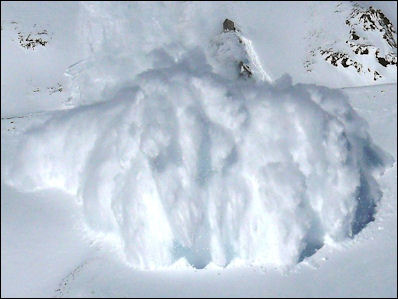AVALANCHES
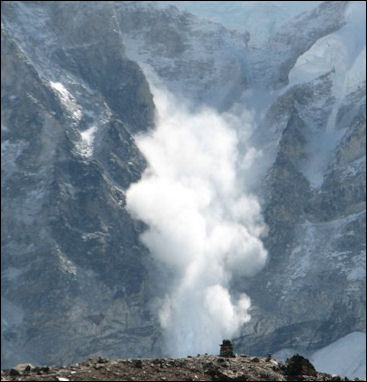
Avalanche on Everest The largest natural avalanches occur in the Himalayas but no one has accurately measured them. Avalanches are landslide of ice and snow. Compared to mythical German monsters that flies without wings, sees without eyes and strikes without hands, they can reach speeds of 200mph; attain a mass of more than a million tons and attain forces 48 times stronger than those needed to demolish a frame house. Severe avalanche can snap trees like toothpicks, dump snow in 30-foot-high heaps and leave behind acres of destroyed buildings. [Source: National Geographic, September 1982]
Avalanches may flow like rivers of icy cement, entombing everything in their path. Or they may hurtle like rockets, throwing before them blast waves that can blow houses apart and toss trucks like toys." The worst kind of avalanches, slab avalanches, occur when a thick top layer of snow slips of a bottom layer of sugar snow (See Below). The deeper the sugar snow or the thicker the top layer, the more severe the avalanche is.
Describing a severe avalanche, David Cupp wrote in National Geographic, "At the start, an avalanche slab breaks off and fractures. As it gains speed the descending mass breaks up into a river of flowing snow, generating a cloud of snow that may roil upwards hundreds of feet. Inside the avalanche the dense core picks up more snow as it advances, accelerating in growth and speed...As velocity increases, the onrushing mass may rise and become airborne, riding friction free atop a cushion of air.
"The avalanche thunders down the mountain. Shock waves hit first...starting with a low whistle and swelling instantly to a screaming crescendo... Massive steel beams flex, bending and twisting as if made of rubber. As snow-laden wind shrieked through, the structure exploded. A third force, rampaging snow, destroyed almost everything still standing."
Avalanches are not dangerous because they occur but because people and property get in their way. The high population density is one of the main causes of avalanche disasters. More and more buildings are being built in harms way, more and more trees are being cleared and more resorts are being built higher and higher up in the mountains, where there is no avalanche protection from trees and avalanches are more likely to be triggered by high winds.
Just because snow looks stable does not mean there is no risk of an avalanche. Below the surface, there could be an unstable snow layer just a few millimeters or a few centimeters thick. Even air currents generated by an avalanche present great danger. Even when the main avalanche stops at a point where the slope levels out, the air currents continue forward, carrying significant amounts of snow. Blasts of wind can cause damage far from where the main avalanche stopped.
Causes of Avalanches
Avalanches occur on slopes pitched at angles greater than 20 degrees, with some 90 percent occurring on slopes of 20 to 45 degrees. On steeper slopes snow doesn't accumulate. On more gentle slopes, the snow doesn't slide.
Surface avalanches can reach speeds of 300kph and kick up snow clouds that reach hundreds of meters high. On a typical surface avalanche, a one-centimeter-thick “weak layer” of loosely joined snow particles, lies under 90 centimeters of surface snow. The weak layer can break apart very easily causing the snow and ice on top of it to slide down the slope. The weak layer is often created by rising and falling temperatures that generate spindly frost crystals that break the bonds between snow particles. The avalanche can be triggersed by additional weight from a snowfall or rising temperatures that cause the weak layer to partially melt and become more slippery.
The greater the snowfall the more likely an avalanche is to occur. Avalanches usually occur when a layer of snow called "sugar snow" (snow that doesn't bond well with other snow) cannot support the weight of additional snow and collapses, causing the top layers of snow to slide. Sugar snow is produced when water vapor condenses, forming loosely bonded crystals, when the temperature difference with the snowpack exceed 10̊C per meter. Unlike sugar snow, settled snow is cohesive and fairly compacted. It occurs when the temperatures in the snowpack are relatively uniform.
The worst kind of avalanches, slab avalanches, occur when a thick top layer of snow slips off a bottom layer of sugar snow. The deeper the sugar snow or the thicker the top layer, the more severe the avalanche is.
Wet snow forms strong bonds and is less likely to be involved in an avalanche than dry powder, which doesn't bond so well. The snow closer the ground is generally warmer than the snow near the surface. It tends to give off vapor that passes through the upper layers of snow and condenses on the snow crystals, causing them to become angular "faceted crystals", which don't bond so well and make sugar snow.
Other factors that cause avalanche: 1) strong winds that produce cornices (overhangs of snow) that can break off; 2) surface snow that melts and freezes, providing a perfect surface for sliding snow;. 3) accumulations of new snow more than an inch an hour; 4) fluffy layers of light snow that create an unstable barrier for snow above it.
Surface Avalanches
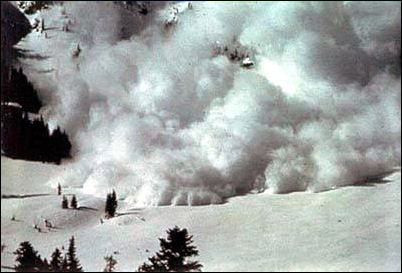
The main characteristic of a surface avalanche is a sliding layer of snow one to five meters deep. Snow is only up to one-third as dense as water, but an avalanche can reach speeds of up to 300 kph. Its force can be as great as 19.5 kilograms per square centimeter, sufficient to damage a ferroconcrete building. [Source: Nobuhiko Harada, Yomiuri Shimbun, January 27, 2011]
Surface avalanche conditions develop in three ways: 1) New snow falls and settles gently on an old snow layer. Rather than fusing together, the two layers are like a pair of stacked boards. 2) A difference in temperature between an old layer and a new layer causes frost, similar to corn or granular snow, to form between them. 3) Hail falls on an old snow layer. When a new snow layer forms, the hailstones act like ball bearings, making it easier for the top layer to slide off.
Prof. Koichi Nishimura of Nagoya University, an environmental science researcher, said, "Even a slight shock, such as one skier passing over it, can make the upper layer slide." Even if there is no structural weakness in the snow, an avalanche can be caused just by the weight of new snow if enough falls in a short period, Nishimura said.
Weather and Avalanches
One weather pattern that produces severe avalanches starts with dry, powder snow early in the season, which bonds less well than wet snow and is more conducive temperature change and the production of sugar snow. If this weak unstable layer is topped by heavy snowfall all that is needed to set off an avalanche is a trigger such as high wind, stress from the weight of the snow, or even a loud noise or the weight of a skier.
The worst avalanches occur after severe storms that dump two or three feet of snow for four or five days on top of already deep snow pack. Another dangerous combination that occurs in coastal areas is when a blizzards is followed by a warm spell and the thresholds between now layers are lubricated by meltwater.
Pollution and the development of ski resorts have striped many mountains of the trees, making avalanches a real problem. The threat of avalanches may or may not be made worse by global warming.
Scientists have identified more than 80 kinds of snow crystals.
Avalanche Avoidance and Survival
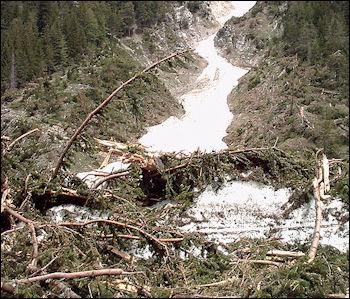
1) Stay out of areas that have just had heavy snows. 2) Avoid slopes with chutes loaded with windblown snow. 3) Stay on the windward side of mountains. 4) Avoid terrain where an avalanche could carry you over a cliff or bury you in a gully. 5) If the snow settles with a "woomph" below you you could be in trouble
Stay out of dangerous back country areas. The dangers of avalanches have become greater since more and more skiers, snowboarders and snowmobiler are going off-piste, heading into back country areas and tackling steeper slopes and at higher elevations. The people are vulnerable to avalanches and may even trigger them.
Avalanche victims usually die of suffocation. They have an 86 percent chance of survival if they are found within 15 minutes because they are often buried with a little air to breath. There is a 50 percent chance of survival if found within 30 minutes. Only five percent of avalanche victims are found alive. The trick is finding them quickly before they suffocate.
Dogs, shovels, probing poles, beacons, metal detectors and long metal probes are used to find avalanche victims. Lasers are not useful because laser beams penetrates only half a meter. Many skiers and hikers carry beepers that can send and receive homing signals so they can be located under an avalanche.
If one is caught in an avalanche one should sit quietly and save their energy for a rescue. The average victim is buried under only a meter of snow. Why can't people just claw their way out? One reason is that after an avalanche runs its course the snow coalesces into an ice-like consistency.
Avalanche Survivor
A woman who was rescued after five days in a collapsed building under an avalanche told National Geographic that after she woke up "it was black; I had no idea where I was or what had happened. She was pinned under wooden lockers and survived by eating snow and wearing clothes pulled out of lockers near where he was strapped.
On the fifth day she became dangerously dehydrated as her supply of snow was running out. "I was just grabbing snow and eating it as fast as I could...I also prayed a lot that day,” she said.
The woman was rescued with the help of 150 rescuers, who dug through 15 feet of snow and debris, and German shepherd rescue dogs. "All of a sudden,” she told National Geographic, "there was a small area where some light shone through, and I saw snow sifting in. I was thirsty, and snow meant water. I grabbed for it ." When the rescuers saw her hand, one shouted, "Anna is that you?"..."I'm Ok, I'm alive," she called back.
Describing the ordeal of another survivor, Cup wrote. "As the building exploded, Jeff grabbed a counter top...The sound changed pitch, to a roar louder than anything Jeff had ever heard. He dived behind the counter as the wall behind him disintegrated...then he floated across the room disappearing in the whiteness...Jeff was hurled 100 feet and except for one hand, buried." He was dug out by a friend, who was protected by 22-ton concrete ski-lift counterweight. and survived.
One avalanche expert who was buried by an avalanche told National Geographic, he had a radio that he could use to call for help but when he was buried it took him 45 minutes to get his hands on the radio
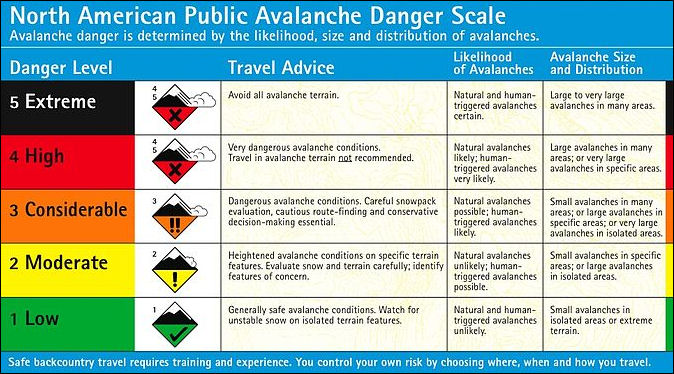
Avalanche Prevention and Prediction
Avalanche prevention measures include 1) banning buildings in avalanche chutes and other danger zones; 2) erecting large walls outside resorts towns to protect them form avalanches; 3) covering roads with reinforced roofs. Some places have zoning laws that restrict construction in high risk areas. Residents are often reluctant to go along with such measures. Many of the buildings destroyed by avalanches are relatively new, which implies that new building were built in avalanche-prone areas avoided by builders of the older buildings.
Other efforts to combat avalanche damage include preventing deforestation, planting trees, and utilizing avalanche forecasting systems, victim detection equipment, building materials with greater strength and flexibility.
Scientists are trying to predict the occurrences of surface avalanches based on analyzing the snow and recording weather conditions and making models and forecasts of when and where these avalanches are likely to occur.
Avalanche patterns are often well known. Avalanches tend to occur at the same places year after year, often open slopes, bowls or gullies above tree line. Scientist are better at predicting avalanches and getting word to authorities to have people moved out of vulnerable areas before a dangerous avalanche can strike.
Scientist attempt to predict avalanches by determining when the snowpack is danger of giving way. To do this scientist typically dig away around a column of snow to determine how deep the sugar snow is. They also check the stress that top layers can bear by dropping weights on the surface of the snow.
Surface Avalanche Warnings and Prevention
The Meteorological Agency already issues avalanche warnings that apply to large areas, but researchers hope to be able to make more detailed avalanche forecasts that apply to individual ski resorts and villages. One promising method, known as Snowpack, involves computer analysis of geographical formations, weather, the depth of accumulated snow, the temperature of ground soil and other factors, which are then used to calculate likely snow stability.
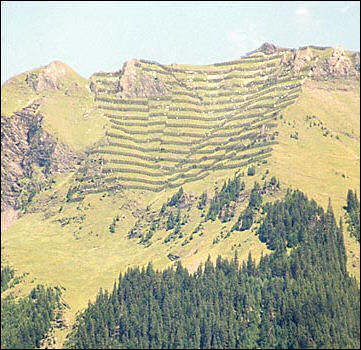
The Snowpack method was developed in Europe and is being adapted for use in Japan. Nishimura and his team used the Snowpack method to assess the stability of accumulated snow in an area of about one square kilometer in the Akiyamago region on the border of Nagano and Niigata prefectures. When an avalanche occurred in the place the team judged the snow to be most unstable, Nishimura said he became confident the method would be effective if put into wider use.
Another avalanche-prediction method has been tested by Yoichi Ito, a researcher for the Public Works Research Institute's Snow Avalanche and Landslide Research Center in Myoko, Niigata Prefecture. om an aircraft above a ski area, Ito used lasers to make a precise analysis of vegetation on the slope and variations in its gradient. Ito used this information to identify areas where the risk of an avalanche occurring was greatest.
In the not-too-distant future, skiers, construction workers and others spending time on mountains in winter might be able to get up-to-date warnings about potential avalanches via their cell phones.
Seismic studies have indicated avalanche patterns.
Avalanche Barriers and Explosives
A variety of fences, nets and barriers have been built to prevent avalanches. Avalanche halting barriers include 300-foot-long earthen walls, giant one-ton boulders, funnels made with 75-foot-high concrete walls, snow barriers constructed of tripod-like concrete wharf-making materials and acres of iron netting to keep rocks in place. These barriers are often built at the avalanche starting zones.
Among the most effective avalanche barriers are long parallel fences made wood or steel. They are designed to stop or reroute avalanches away from buildings and people. The problem with them is they don't always work and they are expensive (about $1 million to save an area of 10,000 square meters).
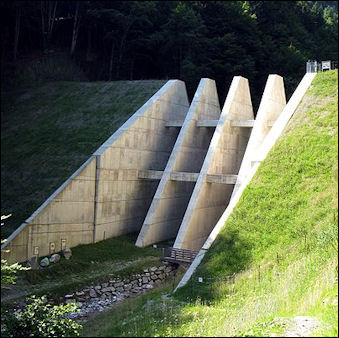
Avalanche protection One of the primary methods of avalanche control used at ski resorts in the Rockies and elsewhere in North America is setting of explosives to trigger small, controlled avalanches to avoid snow build up that can cause dangerous avalanches that can kill a lot of people. In the Alps there are often so many people and buildings in harms way that even small avalanches can not be triggered with risks. Most the dynamiting is done on steep slopes above the timberline.
The small avalanches are created by lobbing explosive devises by hand or firing 75mm or 105mm recoilless rifles into the snowpack. Hand explosives are used for places that can be reached by ski patrols. Cannons are used for places that are hard to get at. To bring down a cornice on an overland ski patrols set off 60 two-pound charges
At Alta ski resort in Utah, ski patrols have fired meter-long artillery shell from 105-millimeter recoilless rifle for more than 60 years at snow crusts and ice sheet to prevent avalanches. On average about 500 shells are fired at the resort each season. The technology works there because the now falls can reach 500 inches a year and the slopes are so steep. For many years most of the shells were surplus ones left over from the Korean War. But now that more people live in striking range of the shells, the ski patrol is looking for alternatives, although they often create more problems than they solve.
Image Sources: Wikimedia Commons, United States Geological Survey (USGS)
Text Sources: United States Geological Survey (USGS), New York Times, Washington Post, Los Angeles Times, Times of London, Yomiuri Shimbun, The Guardian, National Geographic, The New Yorker, Time, Newsweek, Reuters, AP, Lonely Planet Guides, Compton’s Encyclopedia and various books and other publications.
Last updated January 2012

